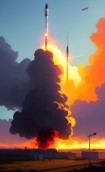|
A buddy of mine was telling me about those, and how dialing in an SA-2 is just a giant pain in the rear end. Our system takes a ton of know-how and training to create a defense design plan as far as where you'll look, what you'll defend, etc. but the actual execution of shooting at a missile or plane is pretty damned easy.
|
|
|
|

|
| # ? Apr 19, 2024 05:03 |
|
SyHopeful posted:Wouldn't the Ju-87G be more analagous to the A-10 RFP than the Hs-129? Eh, maybe. The Hs-129 carried that big rear end Pak 40 anti-tank cannon that was considerably larger than the BK 37s that the Ju-87G carried. (It was actually the largest aircraft mounted gun prior to the GAU-8 coming along). Also, the Hs-129 was heavily armored (had an armor bathtub surrounding the pilot, similar to the A-10) and was specifically designed from the ground up as a low level ground attack/anti-tank aircraft, as opposed to the Ju-87 that was modified to fit that role. That said, like I mentioned Hans-Ulrich Rudel's experiences (specifically, tankbusting in a Ju-87G) did play a large role in the A-X RFP and the development of the A-10. mlmp08 posted:In mid-90s, the air force tested a kinetic kill missile that would be launched by F-15s standing by for missile launches, but it was again decided that they would be too vulnerable and would require a stupid amount of fighters on ICBM duty to get anything done, and the range wasn't fantastic. It's a little unrelated, but that reminded me of this:  F-15 launched ASM-135 ASAT missile
|
|
|
|
mlmp08 posted:so, uh, wall of text. Very cool wall of text, thank you.
|
|
|
|
iyaayas01 posted:Skyraiders are awesome Holy smokes. I didn't know Skyraiders were such good airplanes. And the fact that some of them actually took down jet-powered aircraft is insane, but not very surprising considering the origins of the Skyraider. From what I read of your post, the US Military basically took all the good qualities of the Navy's aircraft and put them on the A-1. Such a great aircraft. When you get done on the A-10 saga, you should do a write-up on the F-86 Sabre. They're the only early Cold War era planes that I know of that could carry tactical nuclear weapons. I don't know of any other planes that could do that, but I'd like to know more.
|
|
|
|
Ace Oliveira posted:When you get done on the A-10 saga, you should do a write-up on the F-86 Sabre. They're the only early Cold War era planes that I know of that could carry tactical nuclear weapons. I don't know of any other planes that could do that, but I'd like to know more. F-84s, F-100s, F-105s, I think F-4s had the capability...
|
|
|
|
Ace Oliveira posted:Holy smokes. I didn't know Skyraiders were such good airplanes. And the fact that some of them actually took down jet-powered aircraft is insane, but not very surprising considering the origins of the Skyraider. From what I read of your post, the US Military basically took all the good qualities of the Navy's aircraft and put them on the A-1. Such a great aircraft. Yeah, the Skyraiders were solid aircraft...there is a reason they were adopted for use by the USAF even as the USN was beginning to retire them after a long career (they served for almost 20 years in USN service, which may not seem like much today but at the time was an eternity...this was a time frame when aircraft would be designed, enter service, and be retired in a decade). And there were only a few models of the F-86 that were modified to carry tactical nuclear weapons...the F-100 Super Sabre, on the other hand... Oh, and those two were definitely not the only aircraft to carry tactical nuclear weapons. We hung them on EVERYTHING during the early years of the Cold War...even...the Skyraider. McNally posted:F-84s, F-100s, F-105s, I think F-4s had the capability... In addition to those, you had a whole host of Navy aircraft, to include the relatively modern A-6 and A-7, as well as the still in service F/A-18, as well as an even larger number of USAF and Allied Air Forces' aircraft, to include the still in service F-16, F-15E, and Tornado. Like I said, we put tactical nukes on EVERYTHING during the Cold War. Maybe that'll be a topic for another post. Hell, we still may or may not have them in use today...look up the WS3 vault system or the NATO Nuclear Sharing program. iyaayas01 fucked around with this message at 00:32 on Dec 29, 2010 |
|
|
|
iyaayas01 posted:And there were only a few models of the F-86 that were modified to carry tactical nuclear weapons...the F-100 Super Sabre, on the other hand... iyaayas01 posted:As an interesting side note, the picture of the F-106 at the very top of this post is of one launching an unguided MB-2 Genie air to air rocket...that was armed with a low kiloton yield nuclear warhead. The F-89 was also capable of carrying the same rocket, while both the F-102 and the F-106 were able to employ the guided subkiloton nuclear armed AIM-26 Falcon (a development of the AIM-4 I mentioned earlier). In the cases of the F-102 and F-106 (both of which were flown by a single pilot without a backseat radar operator), arming these aircraft with nuclear weapons was the only time during the entire Cold War when the two man concept was ignored when dealing with nuclear weapons. What's the deal with that?
|
|
|
|
Ridgewell posted:Now I'm confused. In your OP, you write I would think it has something to do with the nature of the nuclear mission since the F-106 was firing an Air to Air Missile(probably over uninhabited/friendly territory) and therefore defensive in nature there probably wasn't a need for a national command authority release of the weapon and the pilot could act independently?? I have no idea if that is accurate or not I'm just guessing
|
|
|
|
Just got back from a day trip to Albuquerque. Went here: http://www.nuclearmuseum.org/ Will post pics sometime tomorrow.
|
|
|
|
Ridgewell posted:Now I'm confused. In your OP, you write Interceptors armed with nuclear air-to-air missiles would probably have a greater latitude to fire their weapons (thus the abandoning of the two-man concept) due to the nature of their mission. Aircraft carrying nuclear weapons as part of a strike wouldn't be authorized to launch without the highest authority and would have only launched if the balloon went up. I mean, you don't point at ICBMs and say "no-man concept!" Same idea here - the tactical nukes don't go until The Button is pressed.
|
|
|
|
McNally posted:Interceptors armed with nuclear air-to-air missiles would probably have a greater latitude to fire their weapons (thus the abandoning of the two-man concept) due to the nature of their mission. Aircraft carrying nuclear weapons as part of a strike wouldn't be authorized to launch without the highest authority and would have only launched if the balloon went up. I was not very clear what I meant in my previous post, sorry. I am not disputing that the two-man rule was ever abandoned (I simply don't know if/when it was). I felt there is a discrepancy betweens iyaayas01's most recent post and his OP. In the OP, he describes the F-106 as the only instance where the two-man rule was abandoned, but in his most recent post, he describes other single-seat fighters (earlier than the F-106) as carrying nuclear weapons. This means that one person, the pilot, had ultimate launch authority. My understanding of the two-man rule is that at any stage of ordering the use of nuclear weapons, two people have to be involved (giving the orders (POTUS and SecDef together *), passing them on, and turning the keys/pushing the buttons). This is nicely demonstrated in the opening sequence of WarGames. Of course ICBMs are not a case of "no-man concept", but the order to launch them has to be given by two people (and sometimes even more, as one Launch Control Center had to confirm the order of another, even though two people sat in either). Similarly, a two-seater aircraft would fulfill that requirement, as the pilot and the weapons systems officer could launch a nuclear weapon (of any kind). I found a definition of the two-man rule by the DOE: http://www.fas.org/nuke/guide/usa/doctrine/doe/o5610_11/o5610_11c3.htm And here is what Wikipedia has to say on it: http://en.wikipedia.org/wiki/Two-man_rule (not very much) Flikken posted:I would think it has something to do with the nature of the nuclear mission since the F-106 was firing an Air to Air Missile(probably over uninhabited/friendly territory) and therefore defensive in nature there probably wasn't a need for a national command authority release of the weapon and the pilot could act independently?? I do not think there should (or would) be any difference in the application of the two-man rule for different nuclear weapons. After all, we are still stalking about nuclear weapons, even if it is a sub-kiloton munition. * I am not sure how well the two-man rule works at the top level, since the President has command/control over the Secretary of Defense and thus might order the SecDef to order the use of nuclear weapons together with him. Still, the actual order has to be given by both, the President alone cannot order the use of nuclear weapons.
|
|
|
|
Pretty sure the difference here is that these small tactical nukes wouldn't be a first-strike option so that during peacetime they would be locked up in a munitions depot magazine with all of the "two man" safeties in the world. A pilot wouldn't have these bolted to his hard mounts during normal peace time operations. Said pilot would only have the option to use the nukes if the balloon went up & (potentially) the President had launched a nuclear strike and in doing so released control of his nuclear forces to his theater commanders to utilize as needed. So the pilot has physical control over the actual release of the bomb onto its physical target but the president & his advisors are the ones who released them upon the world and to the commander/individual pilots and once the president says "Bomb the gently caress out of everyone" there isn't any need for a two-man rule, shits already going down. Ridgewell posted:I was not very clear what I meant in my previous post, sorry. I am not disputing that the two-man rule was ever abandoned (I simply don't know if/when it was). I felt there is a discrepancy betweens iyaayas01's most recent post and his OP. In the OP, he describes the F-106 as the only instance where the two-man rule was abandoned, but in his most recent post, he describes other single-seat fighters (earlier than the F-106) as carrying nuclear weapons. This means that one person, the pilot, had ultimate launch authority. My understanding of the two-man rule is that at any stage of ordering the use of nuclear weapons, two people have to be involved (giving the orders (POTUS and SecDef together *), passing them on, and turning the keys/pushing the buttons). This is nicely demonstrated in the opening sequence of WarGames.
|
|
|
|
Ridgewell posted:I was not very clear what I meant in my previous post, sorry. I am not disputing that the two-man rule was ever abandoned (I simply don't know if/when it was). I felt there is a discrepancy betweens iyaayas01's most recent post and his OP. In the OP, he describes the F-106 as the only instance where the two-man rule was abandoned, but in his most recent post, he describes other single-seat fighters (earlier than the F-106) as carrying nuclear weapons. This means that one person, the pilot, had ultimate launch authority. My understanding of the two-man rule is that at any stage of ordering the use of nuclear weapons, two people have to be involved (giving the orders (POTUS and SecDef together *), passing them on, and turning the keys/pushing the buttons). This is nicely demonstrated in the opening sequence of WarGames. I think the idea was that the nuclear air-to-air weapons were the only place where one person had complete control over the weapon. The tactical bombs could have been carried by various single-seat attack aircraft, but (presumably) they never actually flew that way. The interceptors, on the other hand, (probably) actually carried live nukes with a single finger on the button. As far as the two-man rule at the top level, I think the idea is that if the President wakes up with a bad case of Alzheimers and decides to outlaw Russia forever, the Secretary of Defense will have a bit of latitude to say, "gently caress you, sir." Yes, in theory there's the chain of command, but in reality it's never quite that absolute.
|
|
|
|
mlmp08 posted:Just got back from a day trip to Albuquerque. Went here: http://www.nuclearmuseum.org/ Very cool. Looking forward to the pics. Also, that website informed me that Richard Rhodes has another book out: The Twilight of the Bombs. Looks like I've got something else to order. Ridgewell posted:First off, you were absolutely right to call me on this. At the very least, I was unclear what I meant when I was talking about the F-106 (and actually the F-102 as well...also single seat, it carried the AIM-26 nuclear air to air guided missile) and at the most, I may have been completely incorrect. I will attempt to answer the question, although I will say that my attempts to research it further have been rather disappointing thus far. Flikken posted:I would think it has something to do with the nature of the nuclear mission since the F-106 was firing an Air to Air Missile(probably over uninhabited/friendly territory) and therefore defensive in nature there probably wasn't a need for a national command authority release of the weapon and the pilot could act independently?? This is, actually, to my knowledge more or less correct. While it probably wouldn't be the case today (especially with the prevalence of sophisticated PALs in the U.S. arsenal...more on those in a bit) at the time a low yield (sub kiloton) truly tactical weapon like an air to air weapon or a Davy Crockett nuclear recoilless rifle would have been in the hands of a relatively junior officer and would've been intended for fairly short notice use...working our way down from the top, a strategic level weapon like an ICBM or strategic bomber is going to only be used in extraordinary circumstances and send an unmistakable message of "I'm done loving around; let's destroy the world together." These are the very definition of what the National Command Authority need to keep a tight leash on. The next rung on the ladder would be theater/"tactical" level weapons, like IRBMs and strike fighter carried weapons. These are going to be some of the more dangerous ones because while they aren't technically strategic level weapons, their impact will be felt at the highest levels of government as they have the potential to do severe damage to fielded forces, as well as not inconsequential damage to surrounding civilian populations. The danger comes when they are perceived as "tactical" and have the use delegated to a lower level...the widespread use by NATO of these "tactical" kiloton yield weapons on conventional Soviet forces pouring through the Fulda Gap would've been the most likely trigger for escalating a Soviet invasion of Europe into global thermonuclear Additionally, a truly tactical weapon would be intended for very short notice use...communication in those days wasn't the best; "real-time" comms on the scale of going direct from the NCA to forces deployed in the field were still a fantasy. As such, a bomber or ICBM may have between a few hours and 30 minutes to respond to a provocation and would have a hardened communications infrastructure in place to convey any orders...the Davy Crockett will have a few hours, tops, between "durr durr durr, goin' to pick up a fraulein" to "HOLY loving poo poo THE SOVIETS ARE COMING!!!!" and, oh by the way, you're now in the middle of a combat zone and communication between you and your battalion is lovely, to say nothing of beyond that, and several Soviet tank columns are rolling up on your understrength company's positions holding a strategic crossroads and "WHAT DO WE DO, SIR?!?" In the case of the air to air missile, you're looking at a matter of minutes from "hey, there's Boris and the gang, flying right up to the coast again" to "...did he just speed up...and turn towards shore...gently caress, they're on an attack profile and, poo poo, they just launched their cruise missiles, too late now" LavistaSays posted:Pretty sure the difference here is that these small tactical nukes wouldn't be a first-strike option so that during peacetime they would be locked up in a munitions depot magazine with all of the "two man" safeties in the world. A pilot wouldn't have these bolted to his hard mounts during normal peace time operations. Space Gopher posted:I think the idea was that the nuclear air-to-air weapons were the only place where one person had complete control over the weapon. The tactical bombs could have been carried by various single-seat attack aircraft, but (presumably) they never actually flew that way. The interceptors, on the other hand, (probably) actually carried live nukes with a single finger on the button. This is actually (at least somewhat) incorrect. NATO strike fighters (F-100s, F-104s, F-4s, Tornadoes, F-16s, etc.) during the Cold War stood what was called Victor Alert or Quick Reaction Alert fully fueled, armed with a few "tactical" kiloton range weapons, and prepped in hardened shelters at the end of the runway ready to go on a minutes notice. The question becomes whether or not they actually ever flew this way, and if they did fly, were the PALs enabled? PALs are Permissive Action Links which are, in a nutshell, a very complex sophisticated "lock" on a nuclear device that prevents unauthorized tampering/detonation. PALs were first instituted on U.S. nuclear devices in the early '60s due to two reasons: first, the U.S. political establishment did not trust (with good reason) some of its military's leadership. Second, the NATO Nuclear Sharing Program had U.S. weapons deployed in foreign countries at foreign bases for employment by foreign troops; the weapons remained ostensibly under the "control" of U.S. personnel, which posed a threepronged issue: first, since they were on a foreign base and would be employed by foreign personnel, the weapon was arguably under the control of a foreign government, a violation of federal law; second, that possible control posed a more practical problem, which was that if the government of one of those nations decided to go rogue and order its military to attack, there might be little the U.S. personnel at the base could do to stop them, particularly if it was on, for example, a jet that was already cocked on Victor Alert; and finally, these deployments by design put the weapons into closer proximity to the Soviet Union, making their possible capture in the event of war a more likely possibility. The PALs were designed to ease all these concerns by providing the NCA with a means to retain absolute control over all nuclear weapons (even if military personnel had physical access to a weapon, they would be unable to fully arm it without the PAL codes, which would only be given in a properly authenticated Emergency Action Message that would only be able to be properly interpreted by U.S. personnel) and by ensuring that any unauthorized attempt to access/use the bomb (by a friendly foreign government or by Soviet forces) would result in the bomb deactivating itself to the point of, at a minimum, requiring extensive maintenance at a U.S. facility. While on alert, aircraft would still be following the two person concept, in that there would always be at least two people in the presence of the aircraft (usually the pilot and crew chief). However, if/when the plane launched, if the plane was single seat they would be violating the two person concept even if the weapon's PAL had not been enabled. I do distinctly remember reading that bit about the F-102/F-106 somewhere, and it wasn't somewhere random...it was a fairly credible source. Unfortunately, I can't remember where. Ultimately, I believe this is what the thought process was and what I should've written: F-102s/F-106s were the only times when the two person concept was routinely violated, as they would regularly fly with nuclear armed missiles. The aircraft on Victor Alert would fly occasionally, but it was generally in response to a mock scramble, and they would only remain airborne for a short period of time...they wouldn't regularly tool around the sky armed with nuclear bombs, because weather in Western Europe is terrible much of the year and the mishap rate among NATO tactical fighters in the '50s and '60s (and even into the '70s and '80s) was ridiculously high. Not exactly the kind of environment you want to regularly be carting nuclear weapons around in. The only time that such aircraft would be airborne for an extended period of time would be in response to a real alert where they would be jetting east to turn the East from red to charred glowing black. As an aside, fun fact about the PALs...the U.S. military leadership was so opposed to them, ostensibly because of worries that the codes would prevent the weapons from being employed in an expedient manner, that SAC ordered as a matter of written policy that the PALs on ICBMs be set to 000000000. Kind of defeats the purpose...this wasn't changed until the late '70s, almost two decades after PALs were first ordered on all U.S. nuclear weapons. Of course, they weren't on ALL weapons until the late '80s. Space Gopher posted:As far as the two-man rule at the top level, I think the idea is that if the President wakes up with a bad case of Alzheimers and decides to outlaw Russia forever, the Secretary of Defense will have a bit of latitude to say, "gently caress you, sir." Yes, in theory there's the chain of command, but in reality it's never quite that absolute. It's more than a bit of latitude...the concept of a two person system starting at the top is what underpins the entire system we have set up. If there was a shred of doubt that a properly authenticated launch order EAM was in some way wrong, our entire nuclear deterrence system would collapse. Crimson Tide actually does a pretty decent job of exploring this subject, even if it had stupid poo poo for the sake of drama and gets a lot of the technical aspects wrong. The other guy in a release of nuclear weapons scenario doesn't have a "bit of latitude" to say "gently caress you, sir," he is REQUIRED to say that if he feels it is an invalid launch order. iyaayas01 fucked around with this message at 17:00 on Dec 29, 2010 |
|
|
|
iyaayas01 posted:We hung them on EVERYTHING during the early years of the Cold War...even...the Skyraider. Did the Soviets put tactical nukes on their planes, too?
|
|
|
|
I went to the National Museum of Nuclear Science in History back in August and had plenty of time to look around, and it is awesome, if obviously new and a bit underfunded. Unfortunately, I didn't really take any pictures then. I took pictures this last time around but we arrived about 45 minutes before closing and so it was a mad dash. Anyway, pictures. Here's the cool Packard limo that ferried around the Manhattan Project scientists. .JPG) The Honset John nuclear rocket, with a 15 mile-ish range. .JPG) Here's the Lance, an SRBM with a max range of 75 miles used by the U.S. starting in 1972 and entirely pulled back by the early to mid 1990s. It carried up to 100kt nuclear warheads or convetional warheads like cluster munitions. We had some 3,000 of these guys at one point. It replaced the Honest John pictured above. .JPG) A Minuteman MK5 RV which survived reentry testing. .JPG) Just some bombs we accidentally dropped on Spain, no big deal. More here: http://en.wikipedia.org/wiki/1966_Palomares_B-52_crash .JPG) Here's the Bomarc, a USAF SAM (kind of) which iyaayas01 described in some detail earlier. .JPG) Nuclear cruise missiles that I cannot remember the name of, and I stupidly forgot to take pictures of their placards. .JPG) The Genie iyaayas01 told us about. .JPG) Trident missile time. If you're as lucky as I was, maybe some old guy will come up and start quoting random facts and figured about it to your wife, intentionally using terms that he knows full well people who aren't in missile delivery or defense won't know! Apparently, the RVs shown aren't to scale. They seem small compared to most diagrams I can find open-source. .JPG) .JPG) It has a smiley face. A slightly taken apart Titan II. Most of the stuff they have outside is in some state of restoration and kind of just laying around. They haven't been open long, so hopefully this stuff gets fixed up and has better displays in the future. Not pictured because they can be seen all sorts of other places are a B-29, B-52, F-105, and A-7. .JPG) Engines with wife for scale. .JPG) Payload section. .JPG) edit: woops didn't mean to hit submit yet.
|
|
|
|
A nuclear landmine/demolition charge. http://en.wikipedia.org/wiki/Tactical_Atomic_Demolition_Munition Note the davy crocket round in the background. .JPG) More modern B-83 strategic nuke. Below is the parachute pack for it which can apparently slow it from 920mph to 50mph in less than 2 seconds. drat. .JPG) .JPG) Radium water, to cure all your ills! .JPG) Don't want to buy bottled water? Make your own at home! .JPG) Delicious vault-food! .JPG) .JPG) For the fallout geeks here, they seem to be playing the CONELRAD mod in the museum. It's awesome.
|
|
|
|
mlmp08 posted:
Pfff... Some cold war buff YOU are. The pointy one is the SM-62 Snark and the black nosed blunt one is the MGM-13 Mace.
|
|
|
|
iyaayas, since you're ammo, any chance of a post on bomb trains? Those things always fascinated the poo poo out of me.
|
|
|
|
rossmum posted:iyaayas, since you're ammo, any chance of a post on bomb trains? Those things always fascinated the poo poo out of me. If you're talking about explosives trains, like how you detonate something, then absolutely. If you're talking about something else, you'll have to explain what it is you're talking about.
|
|
|
|
while we're on requests, anything you can post on glide-bombs without getting into classified info would be awesome.
|
|
|
|
mlmp08 posted:while we're on requests, anything you can post on glide-bombs without getting into classified info would be awesome. So you're talking unpowered guided weapons...like GBU-15, JSOW, etc.? I don't have much experience with those (outside of the JDAM, of course...but whether or not that's actually technically a "glide bomb" is debatable) since being at an F-22 base means we do mainly air to air. But I am not completely ignorant, so I should be able to gin something up.
|
|
|
|
JSOW would be good. Air to Air is largely not that important to me except for predicting who/what will be a leaker during exercises like WTI or virtual flag.
|
|
|
|
iyaayas01 posted:If you're talking about explosives trains, like how you detonate something, then absolutely. If you're talking about something else, you'll have to explain what it is you're talking about. 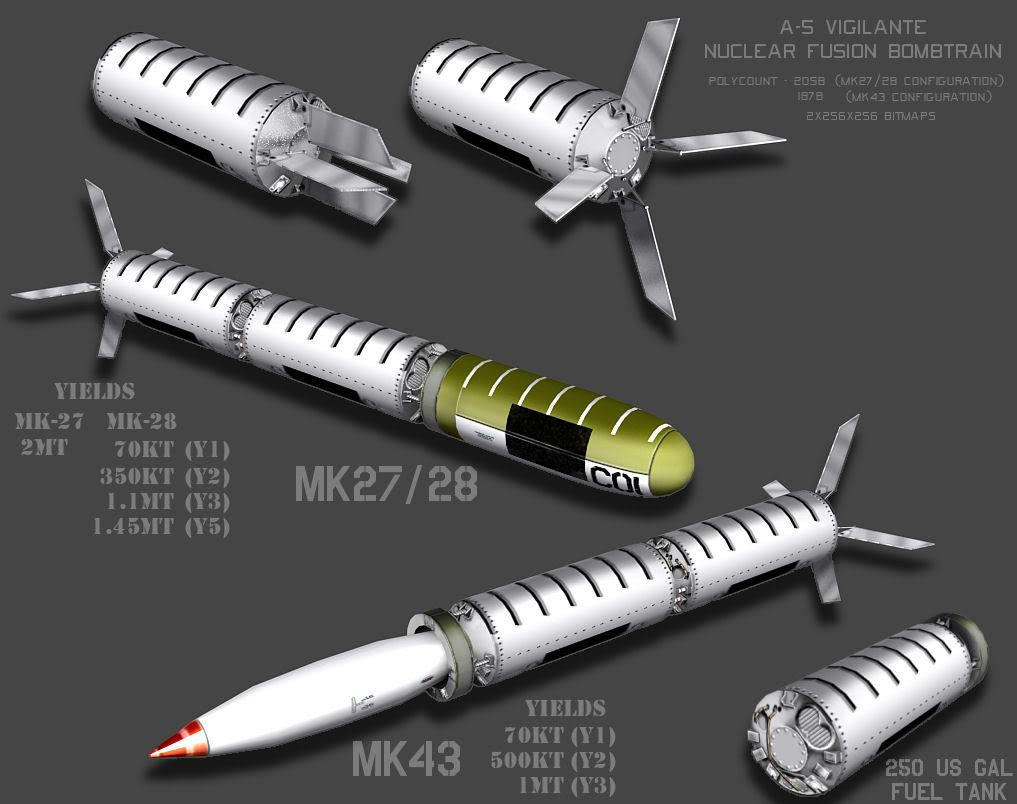
|
|
|
|
rossmum posted:These things: Never heard of these things. Is it just a set of fuel tanks with a warhead in the front? That's almost like the pod under the B-58.
|
|
|
|
NosmoKing posted:Never heard of these things. Is it just a set of fuel tanks with a warhead in the front? That's almost like the pod under the B-58. Integrated wet and weapon station for the underwing hardpoint on the A5?
|
|
|
|
NosmoKing posted:Never heard of these things. Is it just a set of fuel tanks with a warhead in the front? That's almost like the pod under the B-58.
|
|
|
|
The A-5 was the only aircraft to carry things that way...it had what was called a linear bomb bay: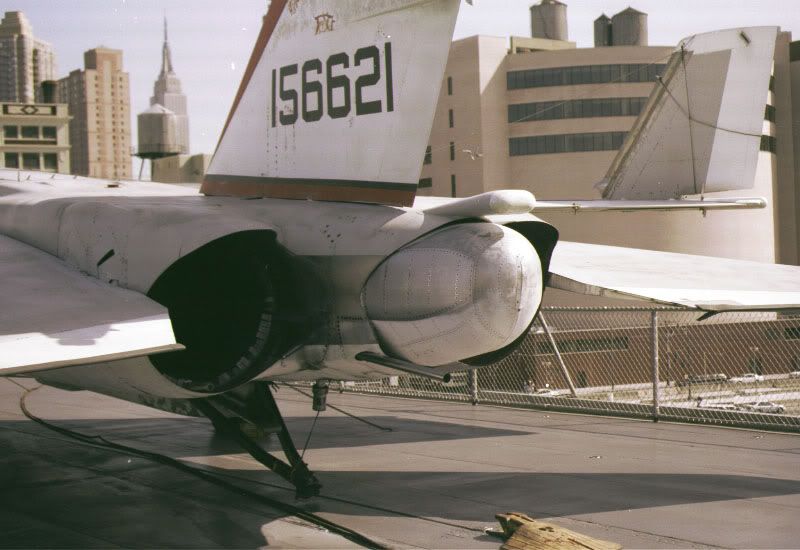 What this meant is that since it was originally designed to only carry a single nuclear weapon (similar to the Air Force F-105) it carried said weapon internally, in a tunnel between the engines. The tunnel was considerably longer than the length of the weapon, so they put a few extra disposable fuel tanks in there, attached to the bomb. When employing the weapon the whole assembly was fired rearward out of the bomb bay at roughly 50 m/s. So basically, this aircraft was designed to poo poo out a nuclear warhead. The system wasn't very reliable, and they never actually carried a live weapon in the bay.
|
|
|
|
iyaayas01 posted:The A-5 was the only aircraft to carry things that way...it had what was called a linear bomb bay: That's almost as dumb as the 'over the shoulder toss' method of low level, but don't blow yourself up, delivery of nukes by tree skimming fast movers. More or less, they came in at treetop level, pulled into a loop, and as they were passing the target they released the bomb so it went backwards and up. The fighter theoretically had enough time to get away from the area before the bomb came back down and blowded everything to smithereenies
|
|
|
|
NosmoKing posted:That's almost as dumb as the 'over the shoulder toss' method of low level, but don't blow yourself up, delivery of nukes by tree skimming fast movers. More or less, they came in at treetop level, pulled into a loop, and as they were passing the target they released the bomb so it went backwards and up. The fighter theoretically had enough time to get away from the area before the bomb came back down and blowded everything to smithereenies This method actually had a much better chance of surviving, as it was intended for use at medium altitude, so the jet would have (probably) had enough time to get far enough away from the detonation, although it would've been less accurate, as the over the shoulder toss enabled some pretty good accuracy (you could use the target as a reference point going into your toss) while the "poo poo out the back" method of delivery imparted an uncertain acceleration to the weapon in the opposite direction of travel, greatly complicating any ballistic calculations. And Fake edit: Actually, since I'm not tired and the scotch glass is only half empty, gently caress it, here we go... Let's say you were the head honcho of SAC during the early days of the Cold War. You were planning new and more inventive ways to blow those godless commie heathens back to the stone age, yet you faced a rather large problem: while your strategic bombers were indeed a formidable force, they were still limited in number, and some of the many targets would have been left uncovered in the initial wave of an attack. Fortunately for you, two new technologies have just become commonplace: air to air refueling, and fighter sized strike aircraft capable of carrying the now considerably lighter nuclear ordnance. Examples of said fighter sized strike aircraft: 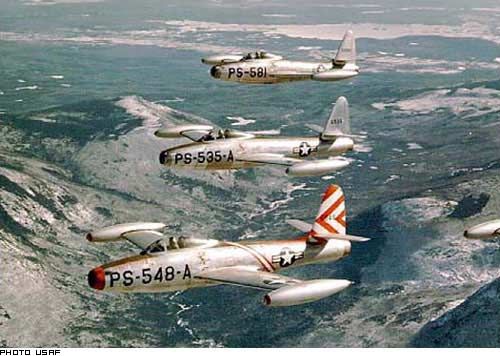 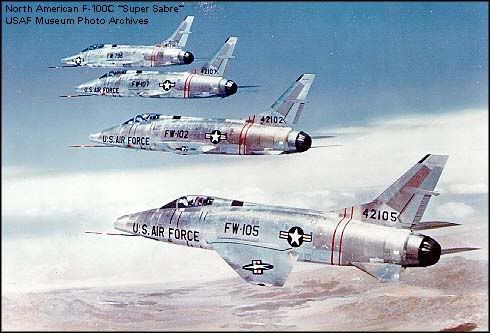 And yes, as mentioned before, 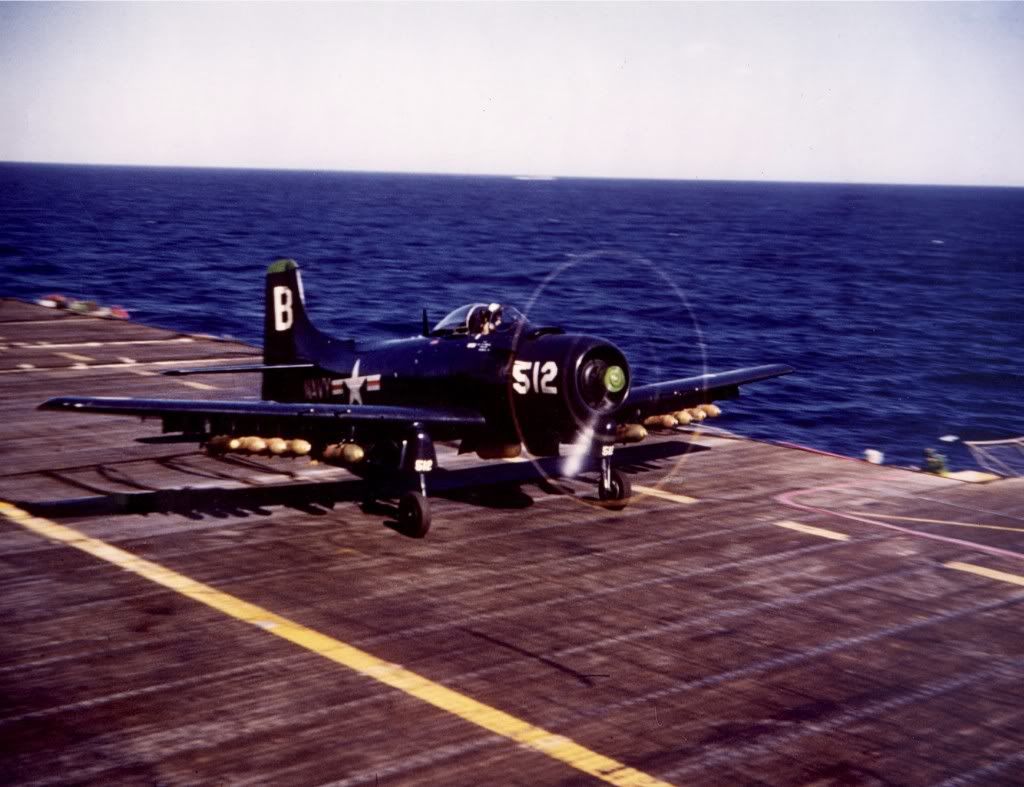 Unfortunately for you, these developments added further complications. For starters, most of these aircraft were single seat and lacked the specialized navigation equipment that your strategic bombers carried. No problem, the fighters would just strike at low level, using the time honored basic navigation techniques of visual landmarks and dead reckoning, honed by lots of memorization of the landmarks along the intended strike path and extensive practice along training runs in the U.S. and Western Europe that had similar topography. This had the added benefit of allowing them to fly beneath Soviet radar coverage, decreasing the warning the Soviets would have of the impending attack. However, this move to low level strike introduced another complicating factor: nuclear weapons are very destructive, and delivering a weapon at low level in a conventional laydown manner would result in the very likely destruction of the delivering aircraft. Of course, given that this was World War III and the pilots would likely be dead before being able to return to their base anyway, this may not have made much of a difference regardless, but generally speaking pretending there's a chance of survival is better for morale as opposed to telling your pilots it's an absolute suicide mission. What to do? This was the solution that was developed:  That, in a nutshell, is the LABS There were actually two different methods developed for LABS...the first is a conventional toss, where the aircraft enters a relatively shallow (15-20 degree) pitch-up prior to release, to loft the weapon to the target. This allowed the delivering aircraft to forgo directly overflying the (probably) heavily defended target, but it also required a known fixed visual landmark to correctly gauge the toss distance. The other method, which was the preferred one, was the over the shoulder method. As shown above, this involved a sharp pitch up almost directly over the target, lofting the bomb several thousand feet into the air. This method had the advantage of allowing the striking aircraft to approach from any direction; all that was necessary was that the striking pilot be able to see the target. By the mid '50s SAC had 6 wings worth of F-84 aircraft that were deployed to Europe via inflight refueling on regular basis. However, its premier strategic bomber, the B-47 (seen below) faced an issue...Soviet defenses were improving, and its designed high altitude attack profile would leave it too vulnerable to interception.  Solution? Put LABS on it too! 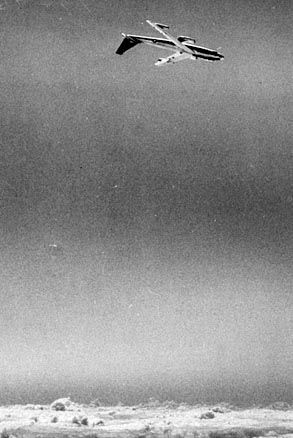 Yes, SAC had its 6 engine strategic bomber fly a low level attack profile designed for tactical fighters that culminated in a full loop half roll (i.e., first half of a Cuban Eight) aerodynamically demanding maneuver. This was the Cold War, era of the nuclear depth charge and mortar...compared to those, this was small potatoes. The maneuver itself involved a 2.5 g pull up (the aircraft had a structural limit of 3 g's; anything beyond that risked catastrophic structural failure) followed by flying the aircraft vertically on thrust alone around 85 knots, buffeting right on the edge of a stall. While it was never conclusively proven to a direct result of flying LABS missions, the B-47 fleet suffered serious wing fatigue issues while it was flying the low level LABS missions (probably a combination of the low level flight and the sharp pull ups); 6 aircraft had their wings simply shear off while on low level LABS training missions. This, combined with the introduction of the more capable B-52, led to the removal of strategic bombers from the LABS missile profile. However, in the meantime TAC (Tactical Air Command, the "fighter" air command during the Cold War) had taken over the strike fighter nuclear mission from SAC and was standing Victor Alert on NATO airbases (described earlier in the thread) with its F-100 Super Sabres (aka "Huns".) As mentioned above, the Air Force were not the only ones to use the LABS...the Navy got in on the action with its reciprocating engine powered Skyraider. These aircraft were designated to fly 13+ hour 2,000 mile long missions, cruising along at 140 knots and 50 feet. Here's a link that describes a Skyraider mission far better than I could, so go and read that. Here's just a few fun facts about the Skyraider missions, though...the weapon the aircraft was supposed to carry was the Bureau of Ordnance Aircraft Rocket (BOAR) that was just a Mark 7 nuclear bomb with a rocket attached, intended to give the weapon more loft enabling the aircraft to better escape. Of course, their chances of actually escaping the fireball and blast were slim...one pilot was given the opportunity to deliver a real live (albeit inert) weapon. After delivery, he was 1,100 feet away from the bomb when the explosive charges detonated (when the bomb would've gone off). Surviving a 60 kT at a range of 1,100 feet is a dubious proposition, to say the least. Here's what a few of the Skyraider's pilots' survival plans were (assuming they survived the delivery of their weapons): "Some of us," he recalled, "scouted out very remote locations in Japan that would offer no appealing targets for the Russians. We figured to land on the roadway or wheels up and go live in the mountains for a while." Rather fatalistic times. Anyway, here's a video of a B-47 performing a LABS delivery, and here's a very good Air and Space article on the whole system. Hope you enjoyed that, I've had several beers and a fair amount of Scotch, so any errors were not my fault. iyaayas01 fucked around with this message at 16:01 on Jan 2, 2011 |
|
|
|
Ace Oliveira posted:
To briefly answer this, sort of but not really. It's important to remember to avoid mirror imaging when comparing/contrasting geopolitical entities, particularly regarding comparable military forces on opposite sides during the Cold War (or even today...reference A is the current hullabaloo over the Chinese J-20 being a F-22 CLONE THE END IS NEAR...anyway). The Soviets faced a completely different set of challenges and threats than U.S./NATO forces. U.S./NATO forces faced overwhelming conventional superiority on the part of the Soviets as well as a geographical separation (the Atlantic) between the battlefield and the bulk of follow on reinforcements...this drove another threat, which was the possible closure of the North Atlantic sea lanes. The Soviets, on the other hand, faced the threat of quick U.S./NATO nuclear strikes from Western Europe as well as U.S. carrier battle groups in the Atlantic. As such, their deployment of tactical nuclear weapons was in three main areas: first, on submarines (both torpedoes and cruise missiles) and medium-long range bomber aircraft (carrying long range cruise missiles...the Tu-22M Backfire/AS-4 Kitchen combination is the best example of this) to strike at the carrier battle groups in the North Atlantic; second, larger warheads (high kiloton to low megaton range yield) on short to medium range ballistic missiles (and, to a lesser extent, medium-long range bombers like the Backfire) to serve as a short notice strategic weapon against NATO countries in Western Europe, both as a counterforce strike against high value targets in the NATO military command structure and as countervalue against population centers; and finally, lower yield truly tactical weapons to be used in a variety of ways against fielded NATO forces once the conventional war went nuclear as it inevitably would given NATO's quantitative (and, to some extent, qualitative) inferiority regarding conventional forces. Ironically, now that has almost completely reversed as the Russians are still holding on to large amounts of tactical nuclear weapons post Cold War as a deterrent against the both quantitative and qualitative conventional superiority of U.S./NATO forces. iyaayas01 fucked around with this message at 16:29 on Jan 2, 2011 |
|
|
|
I always thought the Idiot's loop tossed the bomb on the way up the loop at a forward angle, and then the plane finished the half loop and scurried off in the other direction.
|
|
|
|
MazeOfTzeentch posted:I always thought the Idiot's loop tossed the bomb on the way up the loop at a forward angle, and then the plane finished the half loop and scurried off in the other direction. I know I've seen a diagram showing this as an option for the F-111. I don't know how accurate it was.
|
|
|
|
MazeOfTzeentch posted:I always thought the Idiot's loop tossed the bomb on the way up the loop at a forward angle, and then the plane finished the half loop and scurried off in the other direction. Read the air and space article. It describes how you can use the LABS to do either throw the bomb in front of you OR toss it over the shoulder!
|
|
|
|
What you're describing is just an extreme version of normal toss bombing, which was an option for the LABS (as well as normal delivery of conventional bombs). In that case the bomb was still lofted towards the target, the aircraft just continued the half loop and half roll (basically the first half of a Cuban Eight). Here's a diagram that show the difference: (top picture is "traditional" toss bombing, where the aircraft pops up, tosses the weapon towards the target, and then continues forward to overfly the target; the bottom picture is of the type of toss bombing you describe, where the weapon is tossed towards the target and the aircraft performs a half Cuban Eight to fly back in the other direction): The diagram I posted before could be a bit misleading if you interpreted it incorrectly as having the aircraft performing a full loop. What the aircraft did was still a half Cuban Eight, like this: 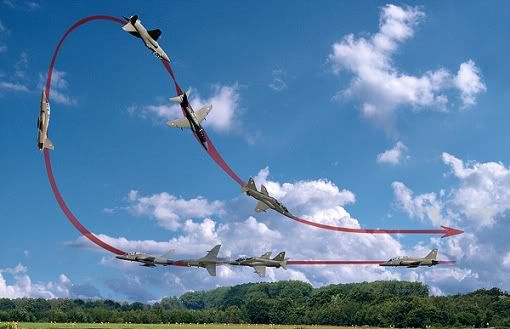 The aircraft would pitch-up sharply and release the bomb after it passed 90 degrees vertical (usually around 135 degrees) and toss the bomb "behind" the pilot (hence the "over the shoulder" description). The aircraft would continue the half loop towards the ground, roll 180 degrees back to upright, and would haul rear end. The reason it might be confusing is that most diagrams (like the half Cuban Eight one I posted above) show the aircraft in only two dimensions...since aircraft travel in three dimensions, this is inaccurate. Which brings me back to the diagram contained in the original post...looking at it, try and perceive it as having the F-84 coming in from your rear left quarter, overflying the target, pulling up beyond the target, releasing as it passed through the vertical, having the bomb fly in the arc towards the target while the aircraft flew through the half loop and rolled upright, flying back towards your right quarter. Hopefully that made sense? Maybe this will help a bit:  Unrelated to that discussion, here's a picture of needles indicator part of LABS that I described earlier: 
|
|
|
|
Thought I'd make up a little spy satellite post, how else did we learn about those darn pesky bears in the woods? Those are my pic-a-nic baskets! The Corona project was a series of spy satellites developed by the U.S. in order to see what our friends in the CCCP, Red China, and other places may be up to without our knowledge. The program became even more important after Gary Powers got shot down in his U-2 over Holy Mother Russia. They were developed and deployed from 1959-1972 and were responsible for some firsts such as: * 1st photo reconnaissance satellite in the world * 1st mid-air recovery of a vehicle returning from space * 1st mapping of earth from space * 1st stereo-optical data from space * 1st multiple reentry vehicles from space * 1st reconnaissance program to fly 100 missions They'd launch the satellite on a Thor-Agena rocket like so: .jpg) This is Discoverer 37 on the launch pad at Vandenberg in January 1962. Discoverer was the cover name for the program as a "scientific" mission. It's true use wouldn't be known until years later. This mission was a failure though, and no one got to see this KH-3 satellite's pretty pictures of people drinking kvass and T-62s drag racing in the tundra.  The first Corona image...a Soviet landing strip in far eastern Siberia, almost to Alaska. That all seems fine a dandy, hell, I can even get better images on Google Earth now...but this was the granddaddy of it all. Of course, no one knew about this secret CIA operation until the 1990s. I think the craziest thing about them (besides being used by the military-industrial complex to misreport the size of the bears) was the way in which the photos were retrieved, by mid-air grab.  The darn thing would tip upside down, poop out a little pod with the film, and parachute it down.  Where the CIA's gophers (U.S.A.F.) would come by and snag them in mid-air with the Flying Boxcar! Hooray C-119!  C-119 just wants to be loved. Agustin Cienfuegos fucked around with this message at 01:09 on Jan 6, 2011 |
|
|
|
Sonic Boom Bitches!!!!.jpg) Go ahead and try to keep up.
|
|
|
|
Agustin Cienfuegos posted:SPY SATELLITES! the way it drops its film modules is pretty slick.
|
|
|
|
Agustin Cienfuegos posted:
AC-119 will make you love it: 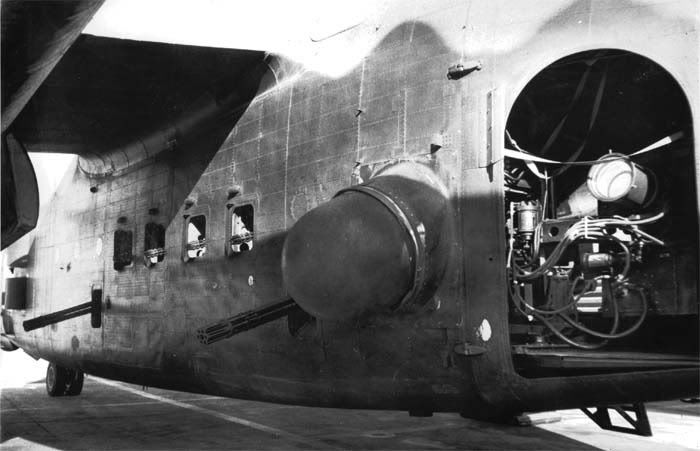 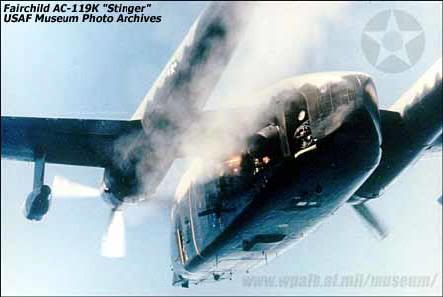 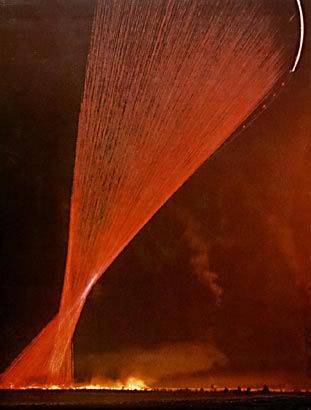 That was a pretty cool spy satellite write up.
|
|
|
|

|
| # ? Apr 19, 2024 05:03 |
|
iyaayas01 posted:Cool AC-119 pics Thanks! I was doing some background reading for a project and they happen to come up, so I thought I'd turn it into a post. Might add a couple more things I came across, such as Ted Molczan (the guy who they programmed spy satellites to hide from) and cool/weird experimental aircraft at "the box".
|
|
|

